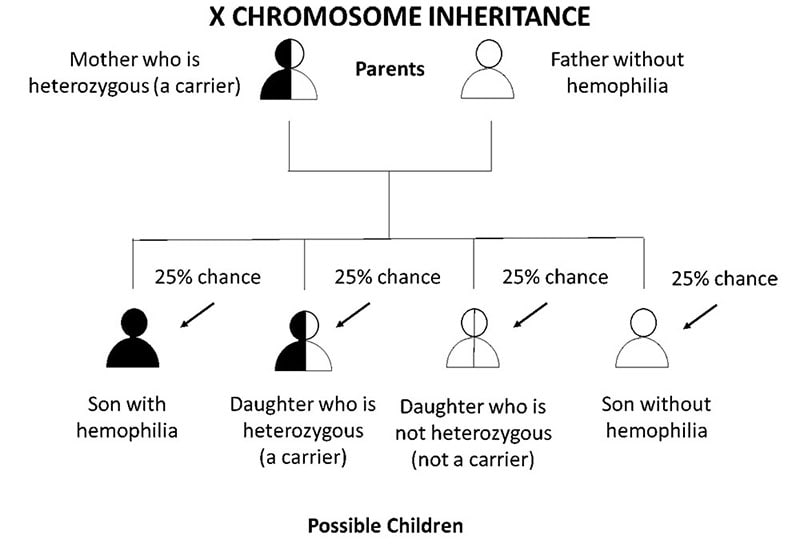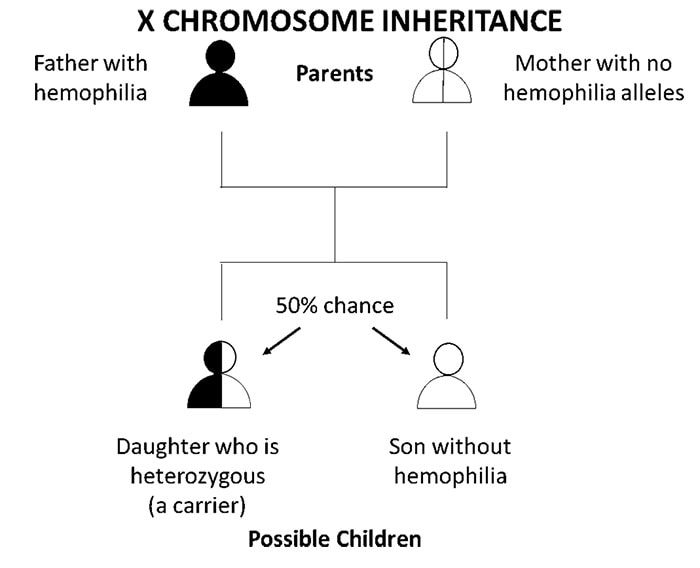How Hemophilia is Inherited
Hemophilia is a bleeding disorder in which blood does not clot properly. Blood contains many proteins, called clotting factors, that can help to stop bleeding after injury or surgery. People with hemophilia have low amounts of either factor VIII (eight) or factor IX (nine), key factors responsible for normal blood clotting.
A person’s genes provide the instructions on how to make proteins, such as factor VIII and factor IX. In people with hemophilia, there is a mutation (difference from normal) in either the gene for the factor VIII protein or the gene for the factor IX protein. The mutation causes the body to produce too little factor VIII or IX. This change in a copy of the gene making factor VIII or factor IX is called a hemophilia allele.
Most people who have hemophilia are born with it. It almost always is inherited (passed down) from a parent to a child. Both hemophilia A and B are inherited in the same way, because both the genes for factor VIII and factor IX are located on the X chromosome (chromosomes are structures within the body’s cells that contain the genes). The X and Y chromosomes determine whether a person’s sex is male or female; females have two X chromosomes (XX) and males have one X chromosome and one Y chromosome (XY). There are no genes for clotting factors on the Y chromosome. This means that males only have one allele for factor VIII and one allele for factor IX. Thus, if a male has a hemophilia allele on his only X chromosome, he will have the disorder.
A female inherits two copies of the factor VIII or factor IX gene, one from her mother and one from her father. A female with a hemophilia allele on one X chromosome usually has a normal allele on her other X chromosome that can produce normal clotting factor, so she has some protection against having hemophilia. A female with one hemophilia allele and one normal allele is called heterozygous or a carrier. Some girls and women who are heterozygous have bleeding symptoms, but usually they are milder than those of boys and men with hemophilia. In rare cases, a female who is heterozygous can have bleeding symptoms that are just as serious as those of a male with hemophilia. A female can also have hemophilia if she inherits hemophilia alleles from both of her parents or if she inherits one hemophilia allele and her other X chromosomes is missing or does not work properly. Hemophilia may be hidden in a family for many generations if it passes only through females who do not have bleeding symptoms.
If a mother is heterozygous (a carrier) for hemophilia and the father does not have hemophilia, each son has a 1 in 2 (50%) chance of getting his mother’s hemophilia allele and having hemophilia. Each daughter has a 1 in 2 (50%) chance of getting her mother’s hemophilia allele and being heterozygous. Overall, there is a 1 in 4 (25%) chance for each pregnancy that the baby will be a son with hemophilia and a 1 in 4 (25%) chance that the baby will be a heterozygous daughter. There is a 1 in 2 (50%) chance that the baby (either a son or a daughter) will not get the hemophilia allele at all and, therefore, can’t pass it down to his or her children.

A father who has hemophilia passes his only X chromosome down to all of his daughters, so they will always get his hemophilia allele and be heterozygous (carriers). A father passes down his Y chromosome to his sons; thus, he cannot pass down a hemophilia allele to them. Without the hemophilia allele, the sons will not have hemophilia and can’t pass it down to their children. Overall, there is a 1 in 2 (50%) chance that the child will be a son who does not have hemophilia and a 1 in 2 (50%) chance that the child will be a daughter who is heterozygous (a carrier). This is true if the mother does not have a hemophilia allele herself. That would be very rare, unless the parents are related.

